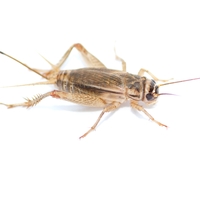How to Identify House Crickets

The Biology of House Crickets
The house cricket is an outside pest. Outdoors, under ideal conditions, the female can lay approximately 700 eggs. She places these eggs in suitable areas for the hatching of the next generation. Indoors, the females usually lay fewer eggs – up to 100 eggs. These overwintering eggs hatch in late summer, with only one generation per year.
Where do Customers See House Crickets?
- They are usually first seen crawling or short-hopping along the yard, starting early to mid-summer.
- As the summer goes by, populations will continue to grow larger and larger. By the time fall arrives, adults wander into structures seeking moisture but also looking for a nice warm place to pass the winter.
- House crickets are usually seen on the lower levels first but have been spotted in light fixtures in severe infestations. They usually are not a problem until they get inside. They are nocturnal and most active at night.
- Most people like the sound of crickets chirping outside. But once inside the house, the singing can become unbearable. The constant or sporadic chirping at night can awaken you and, most of the time, will prevent you from returning to sleep.
- When you get woken up, you go to get the intruder, but when you get close, the male stops chirping. When you go back to bed and try to get back to sleep, he chirps again, and the cycle starts over. Sometimes this prevents you from getting any sleep the rest of the night.
- The male rubs its front wings together, creating a chirping or mating song.
Feeding Preferences of House Crickets
Once inside, crickets feed on various fabrics, eating out large holes (unlike the small holes typical of clothes moths). The crickets’ preferred fabrics are natural fibers — like wool and silk. In addition, crickets will feed on dead insects, live insects, paper, wallpaper glue, as well as just about anything that we would eat.
Do-it-yourself ways to reduce the conditions that harbor and attract house crickets:
- Remove leaf clutter near structure
- Direct sprinklers away from the structure
- Reduce mulch to 2 inches or less
- Seal gaps around doors and windows
- Repair foundation cracks
- Seal around HVAC systems
- Move compost piles away from structure
- Clean all pet food dishes and remove spilled pet food outside
- Repair all leaks in structure
- Seek professional assistance and a pest prevention plan
Economy’s Pest Control for Crickets
Economy Exterminators’ Pest Control Solutions program uses the 4-step approach to solve your house cricket problem:
- Our 1st step is inspecting the property by a Raleigh, Charlotte, or Wilmington customer service representative. It is crucial to know the cricket species involved and the severity of the pest problem. This is especially true with house crickets since some pest control products work much better than others.
- The 2nd step would be the initial treatment by a Customer Service Specialist of all areas the inspection revealed as critical. Economy Exterminators uses the newest and most effective materials to solve this pest problem fast for you. The usual critical areas would be the basements, lower levels, crawlspaces, and outside areas. Since House crickets can infest mulch areas, treating these areas may be necessary for the best protection. Special attention will be applied to all the windows, doors, eaves, and foundations on the outside.
- The 3rd step is a 37-point inspection to identify areas that allow house crickets easy access to your property by either direct access (cracks in the foundation) or food sources that would be attractive to the house cricket.
- The 4th step is an ongoing maintenance program for the next generation of crickets. New infestations will be moving on your property from the adjoining property. Our exclusive Pest Control Solutions program is designed to prevent future infestations. As always, our unlimited extra service is at no charge.
Reach out to our experts to learn more about pest control for crickets and how Economy Exterminators can help you with your North and South Carolina extermination needs!




